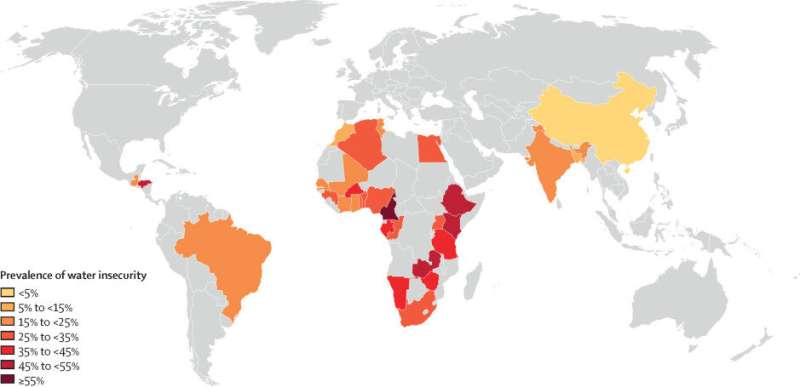Study provides first snapshot of global experiences with water insecurity

Countries in Latin America, Asia and Africa have experienced severe droughts and unprecedented floods in the last year. New research from Northwestern University is the first to provide a more nuanced and global view of the experience of water insecurity.
In a new study published in The Lancet Planetary Health, scientists estimate that 436 million of the 3 billion adults represented by the survey sample were water insecure in 2021. The researchers also were able to pinpoint which groups experience the highest rates of water insecurity.
The study, led by Northwestern anthropologist Sera Young, uses data drawn from a nationally representative sample of nearly half the world's population and a scale designed to measure water insecurity more holistically.
Young is an associate professor of anthropology and global health studies at Weinberg College of Arts and Sciences and a faculty fellow at the Institute for Policy Research (IPR) at Northwestern. Study collaborators include Hilary Bethancourt, assistant research professor of anthropology and IPR at Northwestern.
"These data bring a human face to the water sector, thereby revealing life-altering problems with water that have long gone hidden," Young said.
In 2021, the Gallup World Poll administered the Individual Water Insecurity Experiences (IWISE) Scale, a 12-question survey developed by Young and other scholars, to 45,555 adults in 31 low- and middle-income countries.
The IWISE Scale asked questions such as how often participants worried about not having enough water, how often they were unable to wash their hands, or how often they changed what they ate because of problems with water. The countries were located across four regions: sub-Saharan Africa, North Africa, Asia and Latin America.
The study reveals that 14.2% of those surveyed were water insecure. Countries in sub-Saharan Africa, such as Cameroon (63.9%) and Ethiopia (45%), experienced the highest rates of water insecurity, while countries in Asia like China (3.9%) and Bangladesh (9.4%) were the least likely to experience it.
The researchers also discovered that no single characteristic was always predictive of water insecurity. Individuals who earned a lower income, lived in city outskirts, and those who were more affected by COVID-19 were more likely to be water insecure, but this was not always true. For example, in some countries, water insecurity existed in the highest-income quintiles.
Furthermore, while women are typically thought to experience higher rates of water insecurity than men because they are responsible for more water-intensive chores and collecting water, the study finds that men and women experience similar rates of water insecurity in all but six of the 31 countries.
"If we care about human well-being, it is not enough to measure water availability or drinking water infrastructure, which is what we have done for decades," Young said. "Experiential measures are more holistic, more precise, and can be quickly assessed with the IWISE Scale."
The IWISE scale was created to measure water insecurity at the individual level and provide researchers with more holistic and precise data about water availability and access. Rather than focusing only on access to drinking water, the scale provides granular data about individual experiences with water by examining how water affects cooking, bathing and emotional well-being.
Young urges scholars and policymakers to look beyond water availability and infrastructure when examining water insecurity to capture the scope of the global water crisis. Measuring experiences with water, she says, will allow organizations to create interventions that best target the most vulnerable groups.
"Experiential measures of other key resources, like food, are now standard practice; food insecurity experiences are tracked as part of the U.N.'s Sustainable Development Goals," Young said. "This study demonstrates that this can be done for water insecurity too."
More information: Sera L Young et al, Estimating national, demographic, and socioeconomic disparities in water insecurity experiences in low-income and middle-income countries in 2020–21: a cross-sectional, observational study using nationally representative survey data, The Lancet Planetary Health (2022). DOI: 10.1016/S2542-5196(22)00241-8
Journal information: The Lancet Planetary Health
Provided by Northwestern University


















